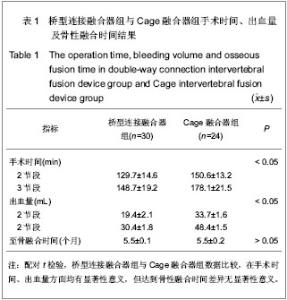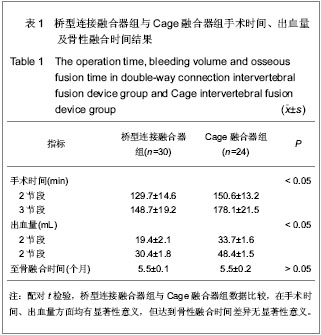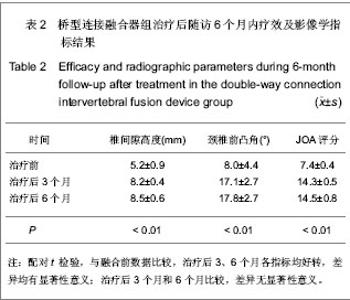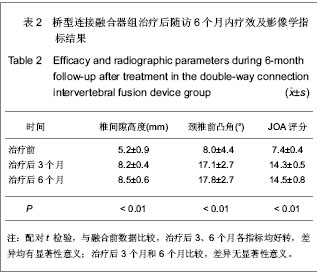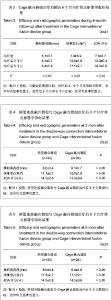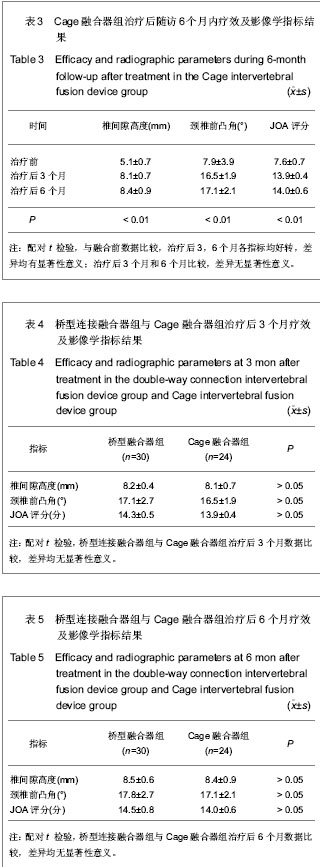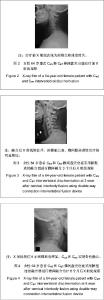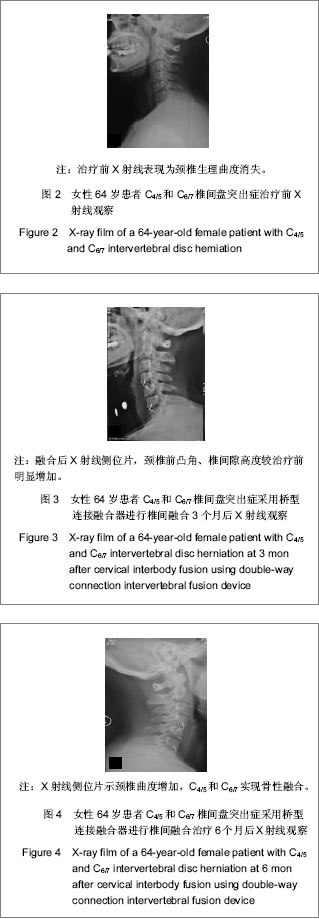Chinese Journal of Tissue Engineering Research
Previous Articles Next Articles
Above two-level segment interbody fusion with double-way connection intervertebral fusion device
Fu Yu, Fu Yun-gen , Luo Jia-quan, Cao Sheng-sheng, Li Jun-ning, Xu Wen-hua
- Medical College of Yichun University, Yichun 336000, Jiangxi Province, China
-
Received:2012-11-28Revised:2013-01-19Online:2013-06-25Published:2013-06-25 -
Contact:Fu Yun-gen, Professor, Medical College of Yichun University, Yichun 336000, Jiangxi Province, China Fuyungen@163.com -
About author:Fu Yu, Medical College of Yichun University, Yichun 336000, Jiangxi Province, China 0816fuyu@sina.com
CLC Number:
Cite this article
Fu Yu, Fu Yun-gen,Luo Jia-quan, Cao Sheng-sheng, Li Jun-ning, Xu Wen-hua. Above two-level segment interbody fusion with double-way connection intervertebral fusion device[J]. Chinese Journal of Tissue Engineering Research, doi: 10.3969/j.issn.2095-4344.2013.26.007.
share this article
| [1] Aryan HE, Lu DC, Acosta FL Jr etal.Bioabsorbable anterior cervical plating: initial multicenter clinical and radiographic experience. Spine. 2007;32(10):1084-1088.[2] Chau AM, Mobbs RJ. Bone graft substitutes in anterior cervical discectomy and fusion. Eur Spine J. 2009;18(4):449-464. [3] Bednar DA, Al-Tunaib W. Failure of reconstitution of open-section, posterior iliac-wing bone graft donor sites after lumbar spinal fusion. Observations with implications for the etiology of donor site pain. Eur Spine J. 200514(1):95-98. [4] Frédéric S, Benedict R, Payer M,et al.Implantation of an empty carbon fiber cage or a tricortical iliac crest autograft after cervical discectomy for single-level disc herniation: a prospective comparative study. J Neurosurg Spine. 2006;4(4): 292-299.[5] Kaiser MG, Haid RW Jr, Subach BR, et al. Anterior cervical plating enhances arthrodesis after discectomy and fusion with cortical allograft. Neurosurgery. 2002;50(2):229-236.[6] Stulik J, Pitzen TR, Chrobok J,et al.Fusion and failure following anterior cervical plating with dynamic or rigid plates: 6-months results of a multi-centric, prospective, randomized, controlled study. Eur Spine J. 2007;16(10):1689-1694.[7] Haden N, Latimer M, Seeley HM, etal. Loss of inter-vertebral disc height after anterior cervical discectomy. Br J Neurosurg. 2005;19(6):469-474.[8] Chu ZM, Liu Y, Chen M, et al. Jingyaotong Zazhi. 2008;29(2): 129-131.储朝明,刘艺,陈鸣,等. 碳纤维椎间融合器在单节段颈椎间盘突出症中的应用及近期疗效观察[J].颈腰痛杂志,2008,29(2): 129-131.[9] Zhang J,He HS, Yuan FJ, et al. Zhongguo Zuzhi Gongcheng Yanjiu yu Linchuang Kangfu. 2011;15(43):8142-8146.张俊,何宏生,袁房均,等. 椎间盘镜下腰椎钉棒置入内固定椎间融合植入物的特点与选择[J]. 中国组织工程研究与临床康复, 2011,15(43):8142-8146.[10] Ren XJ, Chu TW, Jiang T, et al. Zhonghua Chuangshang Zazhi. 2011;27(5):418-422.任先军,初同伟,蒋涛,等.颈椎间盘置换与相邻节段融合的治疗选择[J].中华创伤杂志,2011,27(5):418-422.[11] Chen ZN, Guo TM, Liu Q, et al. Zhongguo Gu yu Guanjie Sunshang Zazhi. 2012;27(3):245-246.陈忠宁,郭团茂,刘强,等. 椎间单枚cage植骨融合结合内固定治疗腰椎间盘突出合并腰椎失稳症[J]. 中国骨与关节损伤杂志, 2012,27(3):245-246.[12] Song HP, Guo QF, Zhang XW, et al. Anterior cervical decompression and fusion by microscope for the treatment of cervical spondylotic myelopathy. Zhongguo Gu Shang. 2012; 25(9):708-710. [13] Sun Y, Zhao YB, Pan SF, et al. Comparison of adjacent segment degeneration five years after single level cervical fusion and cervical arthroplasty: a retrospective controlled study. Chin Med J (Engl). 2012;125(22):3939-3941.[14] Chen DY, Jia LS, Yuan W, et al. Zhonghua Guke Zazhi. 2001;21(5):287-289.陈德玉,贾连顺,袁文,等.颈椎前路带锁钢板临床应用的并发症及预防[J].中华骨科杂志,2001,21(5):287-289.[15] Riley LH 3rd, Skolasky RL, Albert TJ, et al. Dysphagia after anterior cervical decompression and fusion: prevalence and risk factors from a longitudinal cohort study. Spine (Phila Pa 1976). 2005;30(22):2564-2569.[16] Lee MJ, Bazaz R, Furey CG, et al. Influence of anterior cervical plate design on Dysphagia: a 2-year prospective longitudinal follow-up study. J Spinal Disord Tech. 2005; 18(5):406-409.[17] Jia L, Zheng YP, Liu XY, et al. Zhongguo Jizhu Jisui Zazhi. 2011;21(1):28-32.贾龙,郑燕平,刘新宇,等.颈前路减压cage融合术与自体髂骨块植骨钛板内固定术治疗脊髓型颈椎病的中期疗效[J].中国脊柱脊髓杂志,2011,21(1):28-32.[18] Xie N, Tan J, Shen KP, et al. Zhonghua Guke Zazhi. 2003; 23(9):558-561.谢宁,谭军,沈康平,等.颈椎椎间融合器翻修术[J].中华骨科杂志,2003,23(9):558-561.[19] Li HW, Bao D, Ge YH, et al. Zhongguo Zuzhi Gongcheng Yanjiu yu Linchuang Kangfu. 2010;14(52):9823-9826.李宏伟,鲍达,葛彦虎,等.生物椎间融合器与钢板内固定系统置入对邻近颈椎间盘的影响[J].中国组织工程研究与临床康复,2010, 14(52):9823-9826.[20] Jiang B, Liu LM, Cao YQ, et al. Zhonghua Yixue Zazhi. 2012, 92(41):2909-2912.江兵,刘立明,曹燕庆,等.自稳型颈椎椎间融合器在外伤性颈椎间盘突出症中的临床应用[J].中华医学杂志,2012,92(41):2909- 2912.[21] Scholz M, Reyes PM, Schleicher P, et al. A new stand-alone cervical anterior interbody fusion device: biomechanical comparison with established anterior cervical fixation devices. Spine (Phila Pa 1976). 2009;34(2):156-160.[22] Zhang CL, Yang TB, Zhu HH, et al. Zhongguo Zuzhi Gongcheng Yanjiu.2012;16(9):1639-1642.张春霖,杨通宝,朱红鹤,等.比较两种前段膨胀椎间融合器在椎间盘镜下治疗腰椎不稳症的生物力学特点[J].中国组织工程研究, 2012,16(9):1639-1642.[23] Chen Y, Chen DY, Yang LL, et al. Zhongguo Jiaoxing Waike Zazhi. 2006;14(23):1763-1765.陈宇, 陈德玉,杨立利,等.聚醚醚酮颈椎椎间融合器的临床应用及疗效评价[J].中国矫形外科杂志,2006,14(23):1763-1765.[24] Zhan BS, Jiang XS, Ji YF, et al. Linchuang Guke Zazhi. 2012; 15(1):7-9.詹碧水,蒋雪生,姬亚峰,等.颈椎自锁PEEK椎间融合器在颈椎病治疗中的应用[J].临床骨科杂志,2012,15(1):7-9. [25] Zhou J, Li X, Dong J, et al. Three-level anterior cervical discectomy and fusion with self-locking stand-alone polyetheretherketone cages. J Clin Neurosci. 2011;18(11): 1505-1509.[26] Li ZZ, Wu Y, Wu WW, et al. Zhongguo Jiaoxing Waike Zazhi. 2012;20(5):385-388.李振宙,吴叶,吴闻文,等.自锁式椎间融合器在一期后前路联合手术治疗脊髓型颈椎病中的应用(2年随访)[J].中国矫形外科杂志, 2012,20(5):385-388.[27] Chin KR, Ghiselli G, Cumming V, et al. Postoperative MRI Assessment for Potential Compressive Effects of Retained Posterior Longitudinal Ligament after Anterior Cervical Fusions: A Cross-Sectional Study. Spine (Phila Pa 1976). 2012 Oct 24.[28] Yuan JD, Chen X, Liu CL, et al. Analysis of clinical effects of uncovertebral joints resection and decompression for the treatment of cervical spondylotic radiculopathy through anterior approach. Zhongguo Gu Shang. 2012;25(9):721-725. [29] Abbott A, Halvorsen M, Dedering A. Is there a need for cervical collar usage post anterior cervical decompression and fusion using interbody cages? A randomized controlled pilot trial. Physiother Theory Pract. 2012 Oct 17.[30] Yamazaki T, Yasuda S, Uemura K, et al. winstrument for creating bone graft cavities for anterior cervical decompression and fusion: the anterior fusion spinal fork. Neurol Med Chir (Tokyo). 2012;52(9):691-694. |
| [1] | Zhang Tongtong, Wang Zhonghua, Wen Jie, Song Yuxin, Liu Lin. Application of three-dimensional printing model in surgical resection and reconstruction of cervical tumor [J]. Chinese Journal of Tissue Engineering Research, 2021, 25(9): 1335-1339. |
| [2] | Ruan Hanjiang, Jin Genyang, Li Xinwu, Yao Jian, Wu Peng, Zhang Yin, Zhang Shuai, Xiao Jun . Biomechanical properties of three types of posterior single-segment fixation for type II Hangman’s fracture [J]. Chinese Journal of Tissue Engineering Research, 2021, 25(15): 2309-2314. |
| [3] | Cao Bin, Zuo Yuqiang, Li Cunrui, Kang Weifeng, Yu Haiquan, Su Jingyang. Correlation of parameters of lordosis type cervical spine saggital plane in asymptomatic adults [J]. Chinese Journal of Tissue Engineering Research, 2020, 24(6): 898-902. |
| [4] | Cao Bin, Zuo Yuqiang, Du Hanyang, Yu Haiquan, Su Jingyang, Meng Haoyong. Correlation of saggital parameters of cervical and thoracic junction areas in asymptomatic adults [J]. Chinese Journal of Tissue Engineering Research, 2020, 24(33): 5354-5357. |
| [5] | Wu Cai, Luo Tian, Zeng Qinghu, Peng Chengzhong, Liao Tao, Wang Lele, Zeng Zhao. Modified knee spreader combined with minimally invasive percutaneous plate internal fixation for complex tibial plateau fractures [J]. Chinese Journal of Tissue Engineering Research, 2020, 24(27): 4305-4309. |
| [6] | Yang Sheng, Tang Chao, Liao Yehui, Tang Qiang, Ma Fei, He Hongchun, Zhong Dejun. Reasonable choice of occipitocervical angle and posterior occipitocervical angle in basilar invagination patients during occipitocervical fusion [J]. Chinese Journal of Tissue Engineering Research, 2020, 24(23): 3654-3661. |
| [7] | Gao Jian’an, Chen Xi, Zhang Longsheng, Liao Wenbo. Types and advantages of spinal implants in percutaneous kyphoplasty [J]. Chinese Journal of Tissue Engineering Research, 2020, 24(12): 1935-1940. |
| [8] | Zhuo Jin, Wang Shasha, Chen Qiqiang, Cao Xianchang, Zhang Zhongwei. Wrist join function and resetting quality of type C distal radius fractures patients: a comparison of Kirschner wire external fixator, external fixator and volar approach plate internal fixation [J]. Chinese Journal of Tissue Engineering Research, 2019, 23(32): 5126-5132. |
| [9] | Feng Huimei, Liu Lu, Zhang Shaojie, Ma Yuan, Wang Xing, Li Zhijun. Establishment of finite element dynamic simulation models of cervical spine facet joint in a 8-year-old child [J]. Chinese Journal of Tissue Engineering Research, 2019, 23(32): 5181-5187. |
| [10] | Song Sheng, Sun Zhenzhong, Jiang Weimin, Liu Xueguang, Zhuang Yin. ROI-C versus traditional fusion cage combined with titanium plate in treatment of cervical spondylosis: cervical stability reconstruction and intervertebral fusion [J]. Chinese Journal of Tissue Engineering Research, 2019, 23(28): 4474-4478. |
| [11] | Li Wen-xuan, Yu Bao-long, Zhang Pei, Li Rui-feng, Jia Yan-bo. Distribution of Modic changes and its relationship with cervical degeneration in patients with neck and shoulder pain [J]. Chinese Journal of Tissue Engineering Research, 2018, 22(3): 432-437. |
| [12] | Li Wei1, Zhang Hong, Cao Li-jun, Ren Guo-shan, Yan Zhan-ping, Zhao Chang-yi, Gao Zeng-min. Establishment of normal lumbar and osteoporosis three-dimensional finite element models [J]. Chinese Journal of Tissue Engineering Research, 2013, 17(9): 1521-1526. |
| [13] | Zhang Xue-jun, Wang Chen. Digital templating alleviates leg length discrepancy after total hip arthroplasty [J]. Chinese Journal of Tissue Engineering Research, 2013, 17(9): 1527-1534. |
| [14] | Li Guang-wei, Wang Hong-jun, Sun Xiao-zhi. Total knee arthroplasty for the treatment of severe knee disease [J]. Chinese Journal of Tissue Engineering Research, 2013, 17(9): 1535-1542. |
| [15] | Wang Nian-hong, Yan Jun-tao, Sun Wu-quan, Hu Yong-shan, Xia Jun, Wei Li-cheng, Wu Yi, Jia Jie, Ouyang Gui-lin, He Yong, Guo Yan-ming, Xu Jie. Therapeutic effect of early Tuina rehabilitation treatment after total knee arthroplasty [J]. Chinese Journal of Tissue Engineering Research, 2013, 17(9): 1543-1548. |
| Viewed | ||||||
|
Full text |
|
|||||
|
Abstract |
|
|||||
